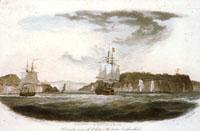A Cautious Beginning:
The Court of Civil Jurisdiction 1791
by Christopher English and Christopher Curran
Ignoring Statute:
The 18th Century Indigenous Regime
The economy upon which the population and the prospects for its growth
depended exhibits some of the same features: long term growth susceptible to
downturns and setbacks which emphasized vulnerability and impermanence.
As in the past, the fishery, apart from vagaries in the migration patterns of the
cod stocks, waxed and waned depending on the crucial variable of external
markets over which the Island had no control. War, in general, was good for
trade. Fortunately for the local population, the 18th century offered plenty of
wars - the Austrian Succession (1740-48), Seven Years (1756-63), American
Revolution (1776-83), and Revolutionary and Napoleonic (1792-1815) -
although the recurring phenomenon of post-war recession, especially in the
1780's, could be devastating. By mid-century, after a generation of war, the
fishery employed 20,000 men and was worth £600,000 per annum. A record
476,000 quintals [100 lb. barrels] of cod was
exported.24
Outside View of St. John's Harbour
From the Naval Chronicle for 1811 by Nicholas Pocock. Pocock joined the Royal Navy
in 1761. He did several
paintings of St. John's harbour.
Courtesy of the National Archives of Canada (NAC: 24563).
 (37 kb).
(37 kb). |
 |
If war-generated prosperity brought a slow, albeit tentative, growth in
population, it was not significant enough for most of the century to force a
reassessment of the statute of 1699. But there were some signs that the gap
between principle and practice was becoming apparent to observers. When the
Board of Trade recommended the establishment of Oyer and Terminer in 1738,
it argued that to do so via prerogative writ would not infringe the statute. How
the Board intended to finesse the powers granted exclusively to fishing
admirals to try cases at first instance and the provision that capital crimes be
tried in England is
unclear.25
Nor were the initiatives which led to the
putting in place of a Customs House and a Court of Vice-Admiralty deemed
inconsistent with the principle of a migratory seasonal fishery. On their face
they were at odds with the statutory reiteration of the 1699 principles signalled
by Palliser's Act (15 Geo III c. 31) in 1775. In all likelihood not much thought
was given to the matter. Britain's claim to a closed mercantilist empire was
under sedge in the last half of the 18th century. Increasingly imperial policy
centred on the need to contain claims to legislative and fiscal autonomy by the
Thirteen Colonies. The Act of 1775 may have reflected a wider need to
rationalize and make uniform imperial policy, to batten down the hatches to
meet the American squall. It also bears the personal stamp of Sir Hugh
Palliser, characterized by Prowse as "according to his lights, an excellent Governor - in labour incessant, the very spirit of unrest, remarkably clear-headed, but very dictatorial".26
|



